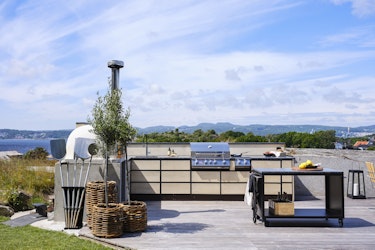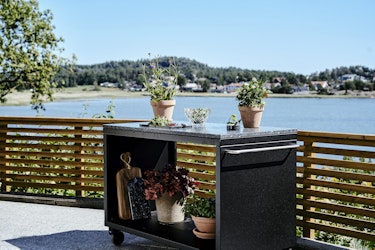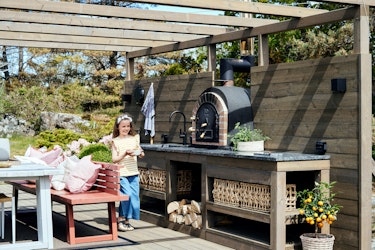
Foto de: Morten Rakke
- Plan your layout
Start by sketching out and planning the floorplan of your outside space. As with all renovation projects, preparation is key and extra care should be taken at these beginning stages to really understand what you’re working with. Take careful measurements and plan exactly what you want to achieve. Think about whether you would like an L-shape configuration, a U-shape or even just a straightforward line. Similar to an indoor kitchen, you will need to factor in measurements for pipework, electrics and any appliances you will want to be integrated into the space.
Don’t forget – if you’re short on space but want to include more surface area, there are options such as movable islands that can be considered. Storage is also an important element to take into account, it’ll be vital to make sure you have enough space to neatly store things as well as protect anything from the outdoor elements.

- Decide on your style
Are you thinking of a rustic, country style scheme? Or a more sleek and modern design? It’s important to decide on your overall style direction early on so that you don’t veer off. Stick to a plan and the end result will be exactly what you have in mind and will fit into your existing outdoor surroundings. Start with pinning your favourite inspiration on Pinterest and adding to your saved tab on Instagram and you’ll have your style moodboard in no time.
- Select the right materials
The materials you choose for your outdoor kitchen will make or break the success of the project. Making the wrong choices will cost you not only in money but in time as well. Opting for the right materials from the start will ensure your outdoor kitchen withstands the test of time and of the great outdoors.
Consider the weather and the climate when selecting your outdoor kitchen worktop. You will need a material that will hold up against changes in temperature, UV rays and the moisture of rain and dampness. Lundhs Real Stone is 100% natural and has a low porosity and low absorption, meaning it is the ideal surface choice for outdoor kitchens. Used as outdoor flooring and on the exterior of buildings all over the world, you can rest assured that a Lundhs Real Stone will withstand nature’s elements.
If you are going to have any metal finishes or wood detailing, be sure to properly factor in how exposed to the elements each material will be. Simply planning and investing in covers will help or choosing certain types of wood over others can have a big impact. The key to getting it right is to do the research and don’t cut any corners as it will only cost you more in the long run!

- Think about water & electricity access
It may seem obvious, but a fully functioning outdoor kitchen will require running water and power. This should have been factored into your planning stages early on, but make sure you have considered any additional work that might need to be carried out. You might have to compromise or change your layout plans depending on logistics and access to electricity and pipework.
- Don’t forget about safety
Last but certainly not least, take safety into consideration when planning your outdoor kitchen. Take advice from professionals in each area such as electricians and plumbers and make sure all the correct permits are in order. If you are planning on installing a grill or barbeque within your outdoor kitchen, make sure you avoid flammable materials and choose a worktop that surrounding surfaces that can withstand high temperatures of up to 300C.
-
We hope our advice and top tips have been useful. Outdoor kitchens are continuing to increase in popularity and with an ever-growing importance on home and family life, we foresee this trend remaining key throughout 2022. For more inspiration on outdoor surfaces, click here.